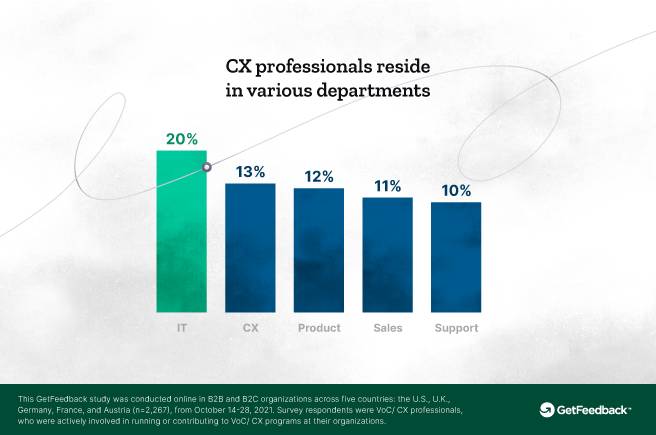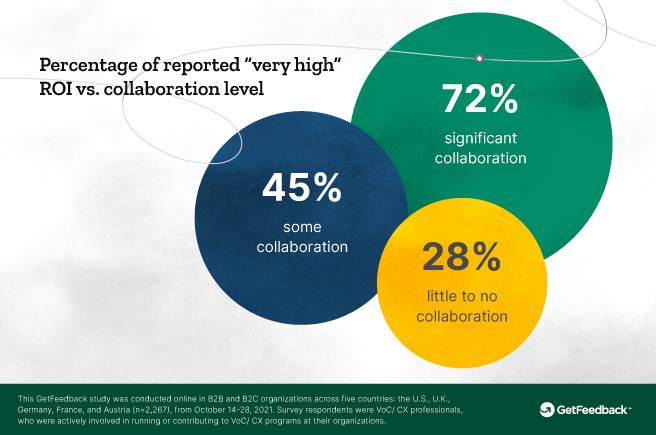I originally wrote today’s post for Momentive.ai. It appeared on their site on February 3, 2022.
The COVID-19 pandemic has amplified existing customer expectations and created new and unexpected ones. Those changes drove GetFeedback to research 2,200 professionals in the United States and Europe. Their findings are presented in The 2022 State of CX Report.
As part of The 2022 State of CX Report, GetFeedback dove into how the CX profession is shaping up regarding compensation, reporting and team structures, skill sets, challenges, and more. This article features the key findings from the report that I find the most significant to thrive in this new era of customer experience.
1. CX PROFESSIONALS RESIDE IN VARIOUS DEPARTMENTS
The finding that CX professionals report to, or reside within, various departments wasn’t a surprise. Still, the largest chunk (20%) sit in Information Technology (IT). I’ve seen CX professionals reside in Marketing, Sales, and Support, but the finding of IT was new to me.
But in a way it makes sense; IT reports to the Chief Information Office (CIO), who oversees the systems and the data that employees throughout the organization use every day to support the customer and the customer experience.
We already know that data is at the heart of designing and delivering a great experience, so it sounds good for the team to report to IT/CIO. But how well is it being executed?
Oftentimes when CX professionals to a C-level executive that isn’t the Chief Customer Officer or the CEO, the focus area is dictated by the purview of the executive’s department.
So, if you report into the head of Customer Support, which experience area do you think you’ll be focusing on? Yes. The first priority will be to ensure that the support experience is a priority. And if you reside under the CMO, do you think you’ll be spending your time on acquisition and retention, or just on acquisition? That funnel doesn’t fill itself.
I’ve seen this happen before. Be wary of it. CX professionals need to look at, understand, and design the experience holistically, end to end, not just within the confines of the department within which they reside. This is an important consideration for organizations as they decide where to build out the CX team.
Fortunately, one trend uncovered by GetFeedback is on the rise: one-third of respondents say that they have a CX leader in place who focuses on the end-to-end experience.
2. TEAMWORK REALLY DOES MAKE THE DREAM WORK
According to the report, teamwork and cross-collaboration are considered top strengths in both the U.S. and Europe.
Whether you’re just getting started with your customer experience transformation efforts or are well on your way, it’s critical to understand that this work cannot be successful without all hands on deck. The entire organization, not just your executives, must be committed to and involved in the work that lies ahead. How do you ensure that happens?
There are a lot of foundational elements that should be in place for the success of the transformation, including establishing a governance structure. This structure stands in the form of committees, which must be cross-functional in order to avoid siloed efforts overtaking the CX transformation work.
The other reason that teamwork makes the dream work is that not all skills needed by the CX team reside on that team. Oftentimes, people with these skills are spread out across the organization; they’re tapped to work with the CX team to design a better experience. Collaboration is critical to success, and shared responsibilities must be outlined and agreed upon by their team leaders.
The team’s leader, whether that’s a Chief Customer Officer or a C-level leader from another department (see #1 above), leads the collaboration effort by:
- Educating the rest of the organization about the customer and the customer experience
- Aligning and uniting executives and all other employees around the customer
- Ensuring that the customer’s needs are embedded in all discussions, decisions, and designs
- Partnering with HR to ensure that employees have a great experience, in turn leading to a great experience for customers
- Collaborating with the CIO to ensure that the right data is (a) accessible and (b) shareable
3. CROSS-COLLABORATION GENERATES GREATER REVENUE
Tied closely to the previous finding is this next one, which states that “CX professionals or teams that significantly collaborate cross-functionally are 27% more likely to have a “high” or “very high” rate of return on investment (ROI) on their programs.” They’re also three times more likely to have high business impact.
This makes sense. We know that seamless and consistent experiences are among customers’ greatest expectations. When you break down or connect silos, work together, share information and insights, and collaborate on experience design, you will reduce effort for your customers, making it easier to show ROI of the work. When customers feel it, you feel it.
By the way, when you break down or connect silos, you make the experience better for employees. It’s much easier for them to get things done without communication or information-sharing barriers.
It’s important to ensure that collaboration happens easily and without any pushback. When you work in a culture that is deliberately designed to put the customer at the heart of all you do, breaking down silos and collaborating cross-functionally becomes much easier. As a matter of fact, by definition, a customer-centric culture is a collaborative one. That’s because culture is the foundation of the organization; it flows organically throughout the business.
IN CONCLUSION
Another finding noted that the bigger the team on which CX professionals worked the bigger the wins (the higher the ROI). That speaks volumes for designing a customer-centric culture in which (1) leaders at the C-level are united and aligned in championing for the customer and (2) teams work together to deliver the experience your customers expect.
For more findings on the current state of the CX professional as well as other emerging industry trends, download The 2022 State of CX Report.
It’s not what you achieve, it’s what you overcome. That’s what defines your career. ~ Carlton Fisk
Annette Franz is an internationally recognized customer experience thought leader, coach, speaker, and author. In 2019, she published her first book, Customer Understanding: Three Ways to Put the “Customer” in Customer Experience (and at the Heart of Your Business); it’s available on Amazon in both paperback and Kindle formats. In 2021, she wrote the manuscript for her second book, Built to Win: Designing a Customer-Centric Culture That Drives Value for Your Business, which is now available to preorder on Amazon, Books A Million!, Target, Barnes & Noble, and more! Sign up for our newsletter for updates, insights, and other great content that you can use to up your CX game.
Read the original post here.




